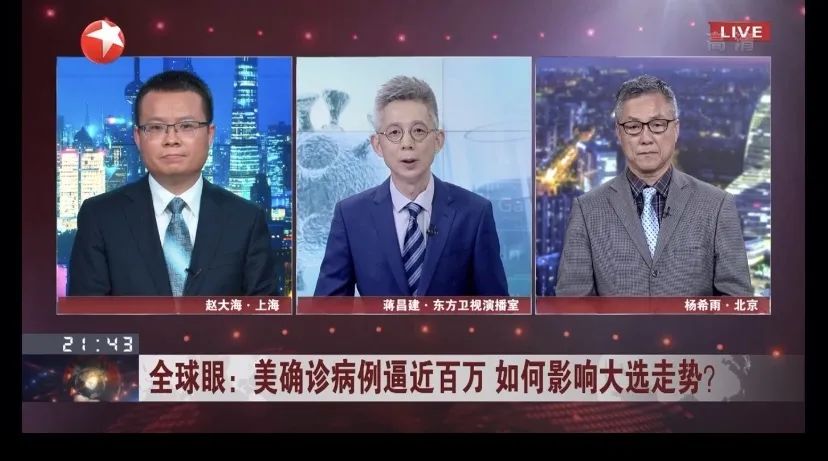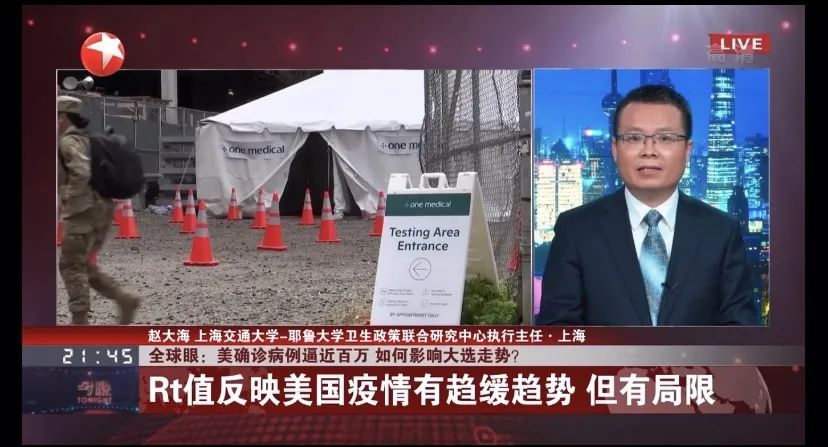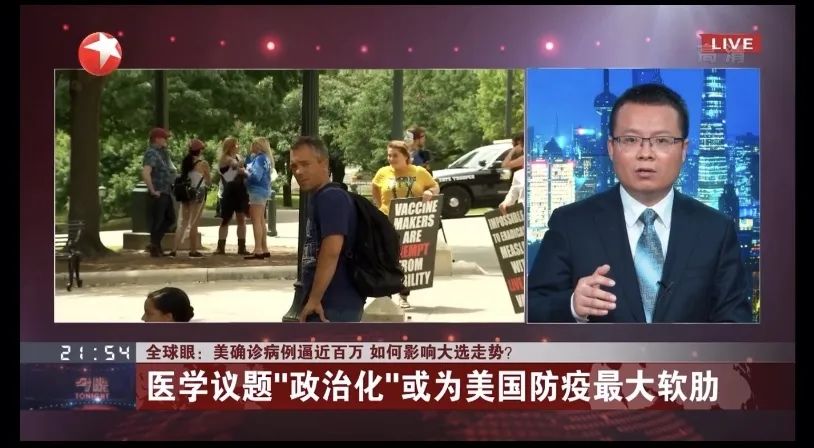上海交大赵大海关于新冠疫情第25次在电视台直播评论:美国新冠疫情暂时趋于稳定,但形势依然严峻

上海交通大学国际与公共事务学院博士生导师、上海交通大学-耶鲁大学卫生政策联合研究中心执行主任赵大海,对于冠肺炎疫情暴发与防控第9次做客上海电视台演播厅进行直播评论,也是第25次在央视/上视进行直播评论。2020年4月28日,赵大海做客东方卫视,在21点20分的《今晚》节目,对美国新冠疫情最新进展与未来防控政策调整等进行了解读和评论。同期北京演播室连线嘉宾是中国国际问题研究院杨希雨研究员。现将有关赵大海的解读和评论摘录如下。

主持人:相关的话题,我们在上海邀请到了上海交通大学-耶鲁大学卫生政策联合研究中心执行主任赵大海先生。刚才我们小片当中谈到Rt值,美国仅有八个州的Rt值大于1,那么根据这个Rt值,我们是否能够得出这样一个结论,就是疫情已经在美国出现了缓和的迹象?
赵大海:首先,美国50个州的Rt值,其中目前只有八个州还在大于1。如果单纯从Rt值来看,确实美国的疫情有趋于放缓的趋势。然而Rt值有一个非常大的局限,就是其完全依赖于各州CDC所上报的确诊的新冠肺炎的病例。然而目前来看,美国总共检测的人数是540万左右,确诊的病例在100万左右,也就是说美国目前核酸检测的阳性率是20%。这个比例是非常高的。譬如说韩国这个比例大约在2%左右,欧洲的国家,目前也没有超过10%的这个比例。美国目前20%的核酸的检测阳性率就代表着,还有很大一部分患者没有进行检测,也就是说美国的Rt值虽然现在大部分州已经小于1,但并不代表着美国的疫情的高峰就过去了。

主持人:接下来这个问题,我们也简短的想问一下这个赵先生,我们都知道在多大的规模解禁是一个科学问题,但是现在实际上是掺杂了一些政治因素,您认为这对控制疫情有好处吗?
赵大海:首先将原本是一个比较简单的公共卫生问题,或者说是医学问题,把它作为一个政治问题,本身对疫情的防控是非常不利的。但是在美国,对整个疫情的防控,在最开始的时候就把这个公共卫生问题变为了政治问题。比如说在一直到3月9号,美国依然没有实施比较积极的防控,特朗普总统本身自己还在呼吁不要太关注新冠肺炎,美国只有不到400人死亡,远远比不上去年冬天的流感。美国真正积极的开始防控是因为美国的两次股市的熔断,才被迫实施的积极防控措施,也就是说美国最开始的时候就把公共卫生问题、医学问题看成了一个完全来服务于总统大选的政治问题。因此,在未来的时候,美国依然会将新冠肺炎疫情的防控作为一个政治问题来进行。
供稿者:国务学院
日期:2020年4月29日
Dahai Zhao' 25th comments on TV during the Pandemic: Situation Remains Grim as Rt Indicates Slower Growth in United States
Dahai Zhao, a doctoral supervisor at School of International and Public Affairs of Shanghai Jiao Tong University and Executive Director of Shanghai Jiao Tong University-Yale University Joint Research Center for Health Policy, has been interviewed by DFTV for the 9th time (the 25th time by CGTV / DFTV) since the COVID-19 pandemic. At 21:20 on April 28, 2020, Zhao commented on that the situation remains grim as Rt indicates slower growth in United States on “Tonight”.
Anchor: We just talked about Rt, and there are only eight states in the United States that have an Rt value greater than 1. Based on this Rt value, can we conclude that the outbreak has shown signs of abating in the United States?
Zhao: First, only eight of the 50 states in United States are currently greater than 1. If we look at Rt alone, it is true that the epidemic in United States tends to slow down. However, the Rt value has a very large limitation, that is, it is completely dependent on the confirmed COVID-19 cases reported by CDC in each state. So far, about 5.4 million people have been tested in United States, with about 1 million confirmed cases. That is to say, the current positive rate of nucleic acid testing in United States is 20%. This percentage is very high. For example, this proportion of South Korea is about 2%, and in European countries this does not exceed 10% at present. The current positive detection rate of 20% in United States means that a large number of patients have not been tested, that is, the Rt value in United States is less than 1 in most states. But it does not mean that the peak of the epidemic in United States has passed.
Anchor: To what extent the closure is lifted is a scientific question, but now there is actually a political element to it. Do you think that will affect containing the outbreak?
Zhao: First of all, taking what was originally a relatively public health issue, or medical issue, as a political problem is very detrimental to the prevention and control of the epidemic. But in United States, the overall response to the outbreak have turned the public health issue into a political one from the start. For example, as of March 9, United States still did not implement more active prevention and control, and President trump himself still urged not to pay too much attention to COVID-19. And he said that it caused by COVID-19 was fewer than 400 of the death in United States, which was far less than the flu of last winter. United States was forced to implement proactive prevention and control measures because of the two stock market meltdowns. That is to say, United States at the very beginning have regarded the public health and medical issues as a political issue that fully served for the presidential election. Therefore, United States will continue to make the prevention and control of COVID-19 a political issue in the future.
Contributor: SIPA, SJTU
Date: April 29

